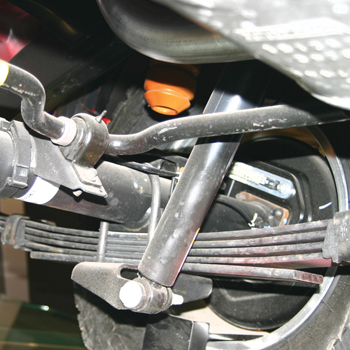Many motorists are uninformed about the impact poor ride control can have on braking, handling, traction, tire wear and driving safety. Many think ride comfort (or lack thereof) is the only reason why shocks or struts might have to be replaced.
 Ride control is especially important with today’s high-tech antilock brake and stability control systems, as well as electronic suspensions and self-leveling suspensions. Stability control systems, in particular, are calibrated to work with the spring rates and dampening characteristics that were engineered into the vehicle. If the shocks or struts are weak and providing poor control, and/or the springs are weak or sagging, the stability control system may not be able to control the vehicle with the same degree of effectiveness as when these parts were new.
Ride control is especially important with today’s high-tech antilock brake and stability control systems, as well as electronic suspensions and self-leveling suspensions. Stability control systems, in particular, are calibrated to work with the spring rates and dampening characteristics that were engineered into the vehicle. If the shocks or struts are weak and providing poor control, and/or the springs are weak or sagging, the stability control system may not be able to control the vehicle with the same degree of effectiveness as when these parts were new.
Worn rear shocks, for example, can allow a lot more wheel bounce when braking hard on a rough road. If the tires are losing contact with the road, it may trip the antilock brake system unnecessarily. When making a sudden steering maneuver, excessive body roll or suspension motion could affect the ability of the stability control system from limiting understeer or oversteer by counterbraking. So with today’s high-tech systems, weak shocks and struts can affect a lot more than ride comfort.
Many vehicles today have some type of electronic suspension with electronically adjustable shocks/struts and/or self-leveling and adjustable ride height systems. Some of the more sophisticated applications combine variable dampening rates with variable rate air springs to optimize handling, ride comfort and cornering agility. The body control computer monitors vehicle speed, steering angle and G-forces, and in some cases suspension movement, to vary the ride control characteristics of the suspension. The shocks and struts may have an internal solenoid valve or electric motor that repositions the valving to vary the resistance of the dampers. On other applications such as Corvettes and certain Cadillacs, the shock may contain a special magnetorheological fluid that changes viscosity (thickness) when exposed to a magnetic field created by a small coil inside the shock.
These high-tech electronic shocks and struts can provide both a smooth ride and firm handling when everything is working correctly. But like ordinary hydraulic shocks and struts, they eventually wear out or fail electronically. And when they reach the end of the road, they can be very expensive to replace. A more affordable option on some applications is to replace the electronic shocks/struts with conventional dampers.
What about handling upgrades? Upgrade options include high-pressure gas charged monotube and twin-tube shocks, some of which are fully adjustable and can be tuned to changing driving conditions. They can have a comfortable ride for everyday driving, then dial up the shocks for increased firmness for a weekend driving event.
In a conventional twin-tube shock absorber, an outer tube that acts as the fluid reservoir surrounds the inner piston chamber. As the shock pumps up and down, the action of the piston forces the hydraulic oil inside to flow back and forth through valving in the bottom of the shock into the outer fluid reservoir. In a monotube shock, there is no outer fluid reservoir. All the fluid remains in the piston chamber, and a floating piston separates the fluid from a high pressure gas charge (which reduces fluid foaming and shock fade).
Monotube shocks and struts dissipate heat better than a twin-tube shock, and typically run cooler for a more consistent feel. The larger diameter of the piston inside a monotube shock also gives the shock greater sensitivity for small piston motions.











